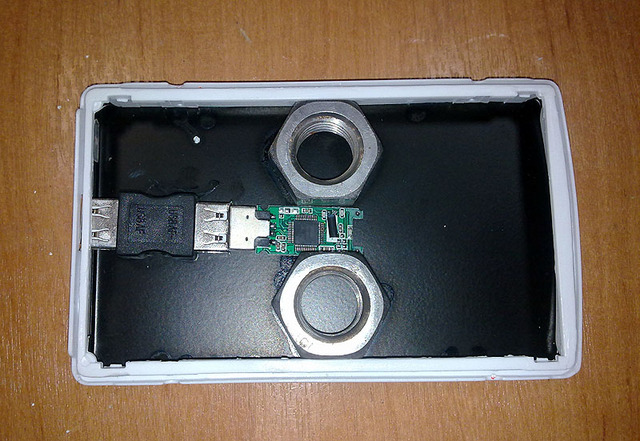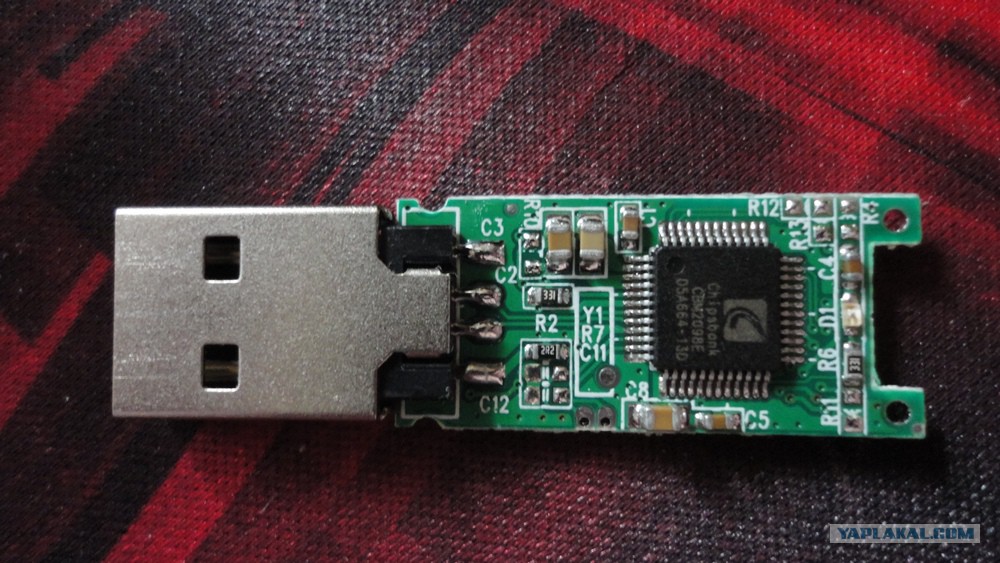-
Posts
2060 -
Joined
-
Last visited
-
Days Won
11
Posts posted by LLegoLLaS
-
-
creare/testare programe java,mobile related(android,in viitor ios).Thanks!
-
Si memory stickuri de 500GB cum fac?

Citeste acest topic
Acel controller poate fi modificat astfel incat atunci cand il conectezi la pc iti va aparea Capacity: X GB,chiar daca utilizabili or sa fie 8 sau 16 (in functie de cat de darnici is)
-
am mai vazut video-ul


iar asta e cel mai ''profi'':

-
mai pe romaneste: Este vorba de fapt de controllerul stickurilor si de faptul ca il poti accesa cu un simplu tool,putand sa modifici si chiar sa plantezi ceva bucurii care sa se execute la conectarea la pc (fara a avea vreo treaba cu autorun)
Also,in acel ''kit'' e vorba de chipuri Phison, folosite in unele stickuri Verbatim,Silicon Power si posibil Apacer (din marcile cunoscute).Asta inseamna ca pentur aproape orice alt chip poate fi adaptata metoda(cele mai multe stickuri ieftine folosesc chip de la Chipsbank - CBM209x)
Se pare ca Kingston DT microDUO foloseste chipuri Phison 2251
Poza random cu un stick care foloseste chip Chipsbank

May be usefull:
flashboot.ru , usbdev.ru
-
n-ai specificat pt cine e.
Ii recomand o bicicleta
-
1.ori de e usb,ori dep e dvd,e tot una.E mai simplu cu usb.
2.pentru viteza si implicit fps.
3.e ok,dar nu e pt gaming
-
Nu inteleg ce vrei asa special.Windows 8.1 x64.
Iti va trebui un SSD si o placa video mai serioasa
-
Ei sunt mai stricti cu seedul pe torrente.Poti sa si descarci de pe unele site-uri chestii pirat,important e sa nu le dai mai departe.
(I may be wrong)
-
Am renuntat la cosmote exact in ziua rebrandingului (dar fara vreo legatura cu asta)
 @Sveratus .... cum sa fie buni si asa?E adevarat ca aveau cele mai multe minute in pretul respectiv (gen optiunea de 8 euro la 6 euro), dar calitatea serviciilor era de cacat.acoperire slaba spre deloc in afara oraselor, 3g(+) indecis si prost...nu mai vorbesc ca ei au 4g doar in sediul lor probabil
@Sveratus .... cum sa fie buni si asa?E adevarat ca aveau cele mai multe minute in pretul respectiv (gen optiunea de 8 euro la 6 euro), dar calitatea serviciilor era de cacat.acoperire slaba spre deloc in afara oraselor, 3g(+) indecis si prost...nu mai vorbesc ca ei au 4g doar in sediul lor probabil 
-
e alt articol bazat pe aceeasi informatie.E ok
-
# Exploit Title: Sky Broadband Router Â? Weak algorithm used to generate WPA-PSK Key
# Google Dork:
# Date: 08/08/2014
# Author: Matt O'Connor / Planit Computing
# Advisory Link: http://www.planitcomputing.ie/sky-wifi-attack.pdf
# Version:
# Category: Remote
# Tested on: Sky SR101 Router
The SR101 routers supplied by Sky Broadband are vulnerable to an offline dictionary attack if the WPA-PSK handshake is obtained by an attacker.
The WPA-PSK pass phrase has the following features:
Â? Random
Â? A to Z Uppercase only
Â? 8 characters long
Â? 208,827,064,576 possible combinations ( AAAAAAAA Â? ZZZZZZZZ ) 26^8
We notified Sky Broadband about the problem in January 2014 yet Sky Broadband are still supplying customers with routers / modems that use this weak algorithm.
At the time, graphics cards were expensive and clustering several machines was not financially viable to the average hacker.
We purchased a used rig in December 2013, comprising off:
Â? Windows 7
Â? I3 Processor
Â? 4GB RAM
Â? 2TB Drive
Â? Radeon HD 5850
We generated 26 dictionary files using Â?mask processorÂ? by ATOM, piping each letter out to its own file, for example:
A: ./mp32 A?u?u?u?u?u?u?u > A.TXT = AAAAAAAA Â? AZZZZZZZ
B: ./mp32 B?u?u?u?u?u?u?u > B.TXT = BAAAAAAA Â? BZZZZZZZ
etc
Each .txt file weighed in at around 60GBÂ?s each. The 26 files took up about 1.6TB of storage.
We now had the complete key space, partitioned into 26 different files. This allowed us to distribute the brute force attack amongst multiple computers. There are other ways with ocl-hashcat but this was the simplest.
Using our Radeon HD5850 on standard settings, we were hitting 80,000 keys per second. Breakdown below:
Â? 26^8 = 208,827,064,576 ( 208 billion possible combinations )
Â? 26^8 / 80,000 keys per second = 2,610,338 seconds
Â? 2,610,338 / 60 seconds = 43,505 minutes
Â? 43,505 / 60 minutes = 725 hours
Â? 725 hours / 24 hours = 30 Days
For Â?185, we had built a computer that could crack the default Sky Broadband wireless password within 30 days. The WPA-PSK handshake we used started with the letter S and was cracked within 96 hours.
We ended up getting a second machine for the same price which resulted in our maximum cracking time being reduced to 15 days.
If youÂ?re using the default password on your Sky Broadband connection, we recommend changing it immediately to a more secure password, using a mix of letters, numbers and symbols.sursa: bugsearch.net
-
ESET Tichie de Margaritar™ Edition.
Desi il folosesc pe unele din pcurile mele...eset se cam duce in jos
-
@misefalfaie din ce stiu,sunt compatibile
-
E mult oricum 650 pt i4.Iar apropo de rama ,daca nu ma insel apple nu fac piese deci va trebui sa gasesti un altul si sa iei ce iti trebuie de pe el
-
-
CPU tau are TDP (total disipated power) 55W.Nu prea merita sa investesti.Daca vrei sa bagi un ban ia-ti alt procesor (un i3,i5) second hand (sandy sau ivy bridge) si apoi poti sa te gandesti la un cooler aftermarket
-
zi si tu exact ce procesor e.Mai multe detalii.Cooleru' nu-l iei doar in functie de procesor
-
Ce vreti voi e foarte ''low level'' ca sa zic asa.Nu poti face asta cu telefonu' conectat la USB. Poate JTAG dar nu stiu daca se poate conecta iphone la jtag
-
1. Scrie intr-un fel pe care sa-l intelegem si noi
2. problema e ca firmware-ul cel mai probabil nu e pe acelasi nand ca si OS (sunt 2 lucruri diferite).Problema nu e cum stergi ci cum treci de securizarea care iti permite sa stergi anumite lucruri.Gandesti prea departe fara sa te documentezi
-
Mersi @ENCODED am bagat si eu niste stickuri

-
Design takes center stage in the next version of Android, with a new look that will feature animated transitions and spruced-up interface elements. What it won't have is a catchy official name, at least for now—Google just calls it “Android L.”
Android's latest release arrives Thursday in preview form, bringing with it an enormous number of changes highlighted by lots of user-facing interface changes and more than 5,000 API features for developers. It’s Google’s biggest release to date, and it will be available in the form of Nexus 5 and Nexus 7 images, together with an SDK for developers.
Google spent a lot of time at Wednesday's I/O keynote in San Francisco talking about “Material Design,” its name for new features aimed at sharpening up interface elements for users. There’s a lot to unravel with Material Design, but the big takeaways are depth and animation. All interface elements can be given a “depth value” by developers, and the Material Design framework will automatically generate subtle shadows and perspective to make it clear which elements are “on top of” others.

material touch animations
It also makes it simpler for developers to make animated transitions from any screen to any other screen, even to another app, so users more easily understand how their apps are interacting. There are tons of touch animations, from ripples to shadows and bouncing, so users can be more clear about exactly where they’re touching and how the app is responding.
Google is starting with Material Design in the Dialer app; it will bring the interface overhaul to all its apps over the coming months.
Android L offers more than just design changes. Improvements to notifications allow users to interact with them right from the lock screen. They’re organized and prioritized, but you can always swipe down to see all of them. A new type of notification, called the “heads up notification,” can pop up over your app without stopping it, allowing you to interact with it or swipe it away without stopping what you’re doing.
Personal Unlocking gives the OS a bunch of new ways to get into your phone. It can take cues from Bluetooth devices or location, so you can set your phone to open without asking for your PIN code if, say, it detects your watch is nearby (proving it’s you), or if it knows you’re at home. (We cover Personal Unlocking in greater detail elsewhere on the site.)

Android L brings “depth” as a central element to interface design.
As predicted, Android L drops the Davlik runtime for the new ART (“Android RunTime”), which improves performance of apps by up to 2x and reduces memory usage. L is also fully 64-bit compatible, ready for the glut of 64-bit, ARMv8 chips coming later this year.
Graphics performance is getting a big boost with Android Extension Pack, which adds a lot of OpenGL ES extensions like tesselation, compute shaders, and geometry shaders to help “close the gap” between Android and desktop-class DirectX 11. This was demonstrated with a demo of Epic’s Unreal Engine.
Project Volta is Google’s name for its efforts to bolster battery life in Android L. It improves the ability of the system to measure battery life, along with a host of changes to various subsystems and new scheduling features for developers. Google promises significant improvements to battery life in its new OS: up to 90 minutes more life in a typical day’s use. Oh, and there’s a new Battery Saver mode that can be triggered manually or set to trigger when the battery gets low.
We’ll have a whole lot more about the “L” release of Android in the coming days and weeks.
-
The constant barrage of headlines trumpeting high-profile security breaches makes it easy to understand at a high level that hack attacks are on the rise, but mere words alone don't truly convey the scope of the constant threats. A mesmerizing example of data visualization by computer security firm Norse lets you see penetration attempts in real time, via a DEFCON-esque map that feels like it was ripped right from the old WarGames movie.
Witnessing the constant ping-ping-ping of individual penetration attempts is hypnotic. If you watch long enough, the map will explode in a frenzy of color, as coordinated mass-hack attacks blast across the globe—most often out of China, and often pointed toward the U.S. The U.S. itself is the steady number two on the map's "Attack Origins" list, however.
But now for the really scary part: This map reveals only the tiniest possible tip of the hack-attack iceberg—penetration attempts against a subset of Norse's network of "honeypot" traps alone. The actual number of hack attempts lighting up the web at any given moment is far, far greater than this nifty experiment can ever possibly show.
Anyway, check it out. Norse's map will give you a healthy respect for what security professionals and websites across the globe have to deal with day in and day out, far more vividly than simple statistics on a page ever could.
sursa:pcworld.com
-
@awnly3jhc2g Sa te aflii in treaba nu?De ce ti-ai face vizite pe un site care nu plateste?

+rep Mecanik
-
Cu parere de rau dar aici nu e TPU.
V-ATI
2.50



Voucher 5 $ [Skype]
in Free stuff
Posted
You just have to add those AcerExplorerRU1,AcerExplorerTW1 and AcerExplorerID1 as your Skype Contacts....
on: not yet confrmed